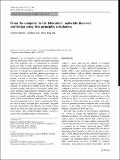From the computer to the laboratory: materials discovery and design using first-principles calculations
Author(s)
Hautier, Geoffroy; Jain, Anubhav; Ong, Shyue Ping
Download10853_2012_Article_6424.pdf (1.073Mb)
PUBLISHER_POLICY
Publisher Policy
Article is made available in accordance with the publisher's policy and may be subject to US copyright law. Please refer to the publisher's site for terms of use.
Terms of use
Metadata
Show full item recordAbstract
The development of new technological materials has historically been a difficult and time-consuming task. The traditional role of computation in materials design has been to better understand existing materials. However, an emerging paradigm for accelerated materials discovery is to design new compounds in silico using first-principles calculations, and then perform experiments on the computationally designed candidates. In this paper, we provide a review of ab initio computational materials design, focusing on instances in which a computational approach has been successfully applied to propose new materials of technological interest in the laboratory. Our examples include applications in renewable energy, electronic, magnetic and multiferroic materials, and catalysis, demonstrating that computationally guided materials design is a broadly applicable technique. We then discuss some of the common features and limitations of successful theoretical predictions across fields, examining the different ways in which first-principles calculations can guide the final experimental result. Finally, we present a future outlook in which we expect that new models of computational search, such as high-throughput studies, will play a greater role in guiding materials advancements.
Date issued
2012-05Department
Massachusetts Institute of Technology. Department of Materials Science and EngineeringJournal
Journal of Materials Science
Publisher
Springer US
Citation
Hautier, Geoffroy, Anubhav Jain, and Shyue Ping Ong. “From the Computer to the Laboratory: Materials Discovery and Design Using First-Principles Calculations.” Journal of Materials Science 47.21 (2012): 7317–7340.
Version: Author's final manuscript
ISSN
0022-2461
1573-4803